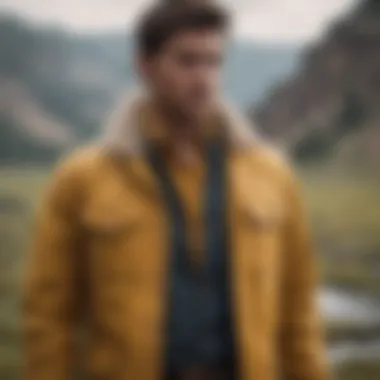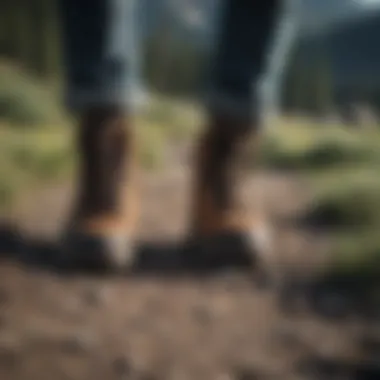Exploring Yellowstone Outfits: Where Style Meets Function


Intro
When planning a trip to Yellowstone, the need for proper outfitting is as critical as preparing an itinerary. The park sprawls over large areas offering diverse environments from geysers to peaceful forests. In this dynamic landscape, visitors face the challenge of balancing fashion with functionality. The merger underscores the relevance of stylishly pragmatic approaches to attire while exploring.
This article will dissect key considerations when choosing outfits suitable for Yellowstone. Alongside practicality, we delve into trends, materials, and essential guidance, ensuring visitors can navigate outdoor activities without looking out of place. Trends will be discussed regarding fabrics that suit the weather, aesthetics that blend in yet stand out, and specific tips to meet both adventure and style demands.
Practical Considerations for Outfits
In choosing outfits, it is important to focus on several fundamental factors:
- Weather Variability: Yellowstone's weather fluctuates. Daytime can be warm, but evenings might require layers. Preparing with adjustments in clothing is necessary.
- Activity Suitability: Hiking, picnics, or simply sightseeing require different types of apparel. Understanding what activities will be embarked on helps in selecting appropriate clothing.
- Comfort Requirements: It's critical to select outfits that allow freedom of movement, especially when engaging in hiking or other physically demanding activities.
Choosing the right attire involves blending these practical insights with personal style, creating a unique exterior suited for engaging with stunning nature.
Style Factors Related to Outdoor Attitudes
Modern clothing brands focus on outdoor sensibilities, merging technical performance with effortless style. Here are some aspects to consider:
- Materials: Synthetics such as polyester or nylon help perform well against both water and wind. Breathable fibers enhance wearing comfort during long explorations.
- Color Choices: Opting for earth tones can keep outfit choices aligned with nature while vibrant colors offer visibility, enhancing the overall experience.
- Layering Techniques: Layered looks can add visual interest. It’s possible to assemble multiple layers, adjusting throughout the day for style and comfort.
Having outlined these essential components of practical outdoor outfits, we are ready to delve into specific looks popular in cutting-edge fashion amidst the great Yellowstone backdrop.
Prologue to Yellowstone Outfits
Yellowstone National Park is a wonderous destination that captivates visitors year-round. However, choosing the proper outfit is essential for an enjoyable experience. One must think about not only the weather but also the activities planned. Appropriate clothing enhances comfort, boosts performance, and reflects personal style while exploring the diverse landscapes Donner, for instance, one might be active in hiking, while another might prefer birdwatching or simply enjoying the views.
Subsequently, awareness of Yellowstone's unique environment plays a key role in maximizing an outfit's utility. Factors such as climate, terrain, and the prevalence of wildlife impact those choices, demanding flexibility in clothing selection. For instance, morning chills contrast sharply with midday warmth, necessitating layered attire that can adapt swiftly. Also, various terrains may include rocky paths, expansive meadows, or potentially muddy areas; thus, footwear choices come into play.
Moreover, a great outfit exemplifies more than mere utility; it encapsulates personality and passion. Style choices are expressed not only through fabric and color, but through how each piece coordinates to reflect individual identity. Understanding this blend of functioning and aesthetics is crucial for those wishing to strike an admirable balance between sophistication and practicality.
In this exploration of Yellowstone outfits, readers will gain clarity on essential clothing technologies, textiles suited for outdoor terrains, and principles guiding on-informed attire choicemitigating discomfort and optimizing style across environments. Overall, thoughtfully curated outfits facilitate engagement with the wilderness while establishing a deeper connection to nature.
Understanding the Yellowstone Environment
The Yellowstone National Park, known for its diverse ecosystem, presents unique challenges and offers various experiences for those who tread its grounds. Understanding this environment is essential when deciding on the appropriate outfits for visiting. The park's conditions dictate not only comfort but also safety during outdoor activities. Weather changes can be abrupt. Therefore, it is vital to consider the interplay between climate, terrain, and outfit practicality.
Climate Considerations
Yellowstone has a varied climate that significantly influences dressing choices. Its elevation leads to distinct seasonal shifts. Summers can be warm during the day but turn chilly at night. Winters are cold with snowfall that covers beautiful landscape. Visitors should be prepared for sudden changes, even in summer.
Here's a summary of significant climate elements:
- Tempature Variation: With highs reaching about 80°F (27°C) in summer, and lows down to -20°F (-29°C) in winter, layering is needed.
- Potential Rain and Snow: Rain is probable, so waterproof materials are essential.
- Elevation Considerations: The park's high altitude can change forecast quickly. Bring layers to adjust easily.
These climate aspects offer insight into which materials work best for effective dressing in Yellowstone.
Terrain Variability
Yellowstone's landscape is extraordinary, from corroded hot springs to towering mountain ranges and sprawling forests. The terrain not only shapes the park’s aesthetics but also impacts activities and required outfits. Hiking trails can progress from flat paths to steep, rugged climbs. Each follows variations in environment requiring different types of outfitting.
Key Terrain Elements to Keep in Mind:
- Rooftop Spaces: Hiking at elevation requires breathable fabric with ideal grip for safety.
- Geysers and Hot Springs: Maintaining distance is key while researching the area. Outfit choices near water are advisable with stain-resistant fabrics since splashes often occur.
- Dense Woods and Open Fields: Pass could change abruptly from sun to shady covered spaces. Multi-layer clothing is practical considering these irregularities.
Recognizing typography prepares adventurers for required versatility in styling, safety priority, and personal comfort while indulging in nature's beauty.
Understanding the Yellowstone ecosystem is crucial in creating fashionable yet practical outfits for excursions.
Essential Components of a Yellowstone Outfit


When venturing into Yellowstone, consideration of outfit components cannot be overlooked. As the landscape varies drastically, outfits must cater to different climates and activities. Each component serves a critical purpose, being neither purely ornamental nor functional. Comfort, protection, and style live in harmony, enhancing user experience versus the raw natural environment. The right gear reduces discomfort and elevates confidence, allowing tourists to fully immerse themselves in nature.
Footwear Fundamentals
Types of Boots
Footwear is arguably the most important aspect of any outdoor outfit. Choosing the right type of boots is crucial for any outdoor activity in Yellowstone. Different terrains require specific boot types tailored for various conditions. Waterproof hiking boots provide superb traction and support, essential for navigating rocky trails.
A specially designed feature called a 'vibram sole' allows for excellent grip on uneven surfaces. This dramatically lowers the risk of slips, enhancing safety during treks. However, heavier boots might feel uncomfortable over long periods, emphasizing the need for a careful balance.
Choosing Breathable Materials
Breathability is vital when selecting boot materials. A breathable boot prevents moisture buildup from sweat, letting your feet remain dry. Common materials like Gore-Tex offer both waterproof capabilities and fundamental ventilation. This is beneficial for prolonged outings in warm weather conditions.
However, while such materials excel in certain environments, they may not provide as much insulation on colder days. Thus, finding boots that offer adequate breathability suited to predicted weather allows for extending comfort margins effectively.
Layering Strategies
Base Layers for Comfort
Base layers play a key role in comfort during outdoor activities. Utilizing fabrics like merino wool or synthetic blends can manage moisture, keeping you dry and comfortable regardless of your exertion level. Base layers often meld seamlessly into your outfit, aiding in temperature regulation, contrasting with traditional cotton options.
Cotton retains moisture often leading to undesired cooling effects in chillier conditions. However, frequently overlooked is the versatility offered—base layers serve not only as a buffer but also for aesthetic cohesion.
Insulating Middle Layers
Insulating middle layers freeze significant warmth while allowing moisture to escape. Selecting materials such as fleece or lightweight down integrates effective heat retention without excessive bulk. This characteristic is essential to manage core temperature during stratified conditions of different elevations in Yellowstone.
Yet, insulation layers often require careful consideration of layering as they can restrict movement if too bulky. Compression-fitting options might counter this, responding better to upper body awareness when navigating challenging excursions.
Weather-Resistant Outer Layers
Outer layers significantly define outfit functionality in varying weather conditions encountered in Yellowstone. A robust, weather-resistant shell is a pivotal component. Materials often utilize waterproof technologies like Hard Shell for rain, ensuring protection from unexpected weather nastiness.
Plus, many outer shells are designed equipped with adjustable features, offering personal customization. A potential downside involves heat-trapping during warm sunny days, prompting changes flexible according to smart climatic shifts throughout distinct times.
Accessories That Matter
Hats for Sun Protection
Sun protection should not be underestimated in Yellowstone's rocky terrain, where sun exposure heightens. A good hat protects against harmful UV rays. Opt for wide-brimmed hats with breathable fabrics to supply requisite shade without making wear uncomfortable.
Features like moisture-wicking indeed offer enhancement in features overlooked while routinely traversing an expansive arid trail.
Gloves and Scarves
Accessories extending temperature control during chilly evenings are crucial. Gloves made from warm materials maintain functionality while added protection from nature’s gambit. Scarves can serve dual roles, not only providing an aesthetic touch but additionally blocking any harsh winds during hikes.
When selecting gloves and scarves, consider modularity. Items that fit seamlessly into small bags make transitions smoother upon changing temperatures. Balancing between practicality must reflect disproportionately contributing to both connection and warmth across your outings.
Proper outfitting is an investment in both comfort and visual style, harmonizing intense focus on allure alongside usable survival essentials.
By purposely addressing various essential components, functionality integrates seamlessly amid your personal sequenced transgressions through diverse geographic patterns across the natural wonders of Yellowstone. Understanding these elements culminates into sensible organization ensuring preparedness - striking a gratifying balance between your chosen expression style amidst nature's countless articulate accents.
Color and Pattern Choices
Color and pattern do not merely embellish an outfit; they serve essential functions, especially in a dynamic environment like Yellowstone. When selecting outfits, thinking about colors and patterns becomes more than cosmetic. It involves blending into different surroundings, aiming for safety and also style. The elements chosen can have a pragmatic influence, affecting visibility, mood, and even temperature comfort.
Nature-Inspired Palettes


Nature-inspired palettes offer a distinct advantage in outdoor spaces. These colors resonate with the natural world around the park, helping to create a visual connection to the scenery. Shades of green, brown, beige, and subtle blues can enhance the wearer's experience.
Using colors that mimic the environment allows for a more immersive experience. You may appreciate not just the activity of exploration but also the aesthetic balance it brings. Furthermore, earth tones help in tasks such as minimizing visual disparities with the surroundings, making the outfits less disruptive.
Additionally, these palettes often convey calmness. In a setting that can vary from serene lakes to rugged mountains, we benefit from the soothing effects of these hues. When fashioned correctly, outfits can retain a level of sophistication while focusing on nature’s simplicity and allure.
Functional Patterns
When considering patterns, the primary function often focuses on utility. Functional patterns refer to designs that capture attention while serving practical purposes. These textiles can aid in camouflage or blending into specific environments, which is crucial in wildlife observation settings.
For instance, camouflage prints are sometimes beneficial, though ideally chosen for specific activities rather than as casual wear. Stripes, grid, or subtle checks have a tactical aspect that may minimize the wearer’s visibility in different locations, enhancing outdoor comfort. Many outdoor enthusiasts find that technical fabrics often incorporate these patterns, aligning them with function while still being aesthetically pleasing.
The significance of pattern choice goes beyond mere visual appeal. Patterns can also help hide dirt, oil, and wear from outdoor activities, extending the lifespan of the garments. Incorporating functional designs while maintaining a modern touch offers an effective balance of versatility and sophistication.
Utilizing both nature-inspired palettes and functional patterns contributes significantly to enhancing your outdoor experience.
Popular Brands for Yellowstone Outfits
When considering outfits for any outdoor adventure, the right brand can make a significant difference. Popular brands within the outdoor clothing sector have developed a reputation for combining style and practical design. This is especially true for environments such as Yellowstone National Park, where the elements can pose challenges. Investing in these brands provides advantages like durability, optimized design, and often, eco-friendliness.
Outdoor Brands Overview
Choosing the perfect outfit often starts with identifying reputable brands that excel in outdoor wear. Brands like Patagonia, The North Face, and Columbia have garnered attention due to their extensive product lines catering to outdoor enthusiasts.
Patagonia, known for their commitment to environmental sustainability, provides products not only functional but also designed from recycled materials. Their focus on responsible sourcing attracts consumers who care about their environmental footprint.
The North Face offers jackets, footwear, and various accessories suited for a range of climates and conditions. Their innovative designs prioritize protection against adverse weather, making them a clear choice for hikers and explorers looking for reliability.
Columbia combines affordability with performance. Many appreciate their technology-driven designs, particularly their Omni-Heat Reflective lining, which helps retain body heat without bulk. Such elements enhance thermal efficiency while not compromising on style.
These notable brands not only reflect aesthetics but also practicality designed for specific outdoor activities. From hiking to wildlife watching, carefully selecting reputable brands can significantly not just your comfort but enhance your overall experience, particularly in variable climates like Yellowstone.
Sustainable Options
Sustainability in outdoor clothing is becoming increasingly vital. More brands are incorporating environmentally-friendly practices to keep up with consumer demand for better choices. This trend is evident in brands such as Patagonia and REI.
Patagonia has long been a leader in sustainable practices. Their mission statement emphasizes accountability for the materials used and initiatives to minimize waste. When customers purchase from Patagonia, they support efforts that strive for less environmental impact in production.
REI is not just a store but a co-op committed to environmental impact. They curate products from various brands, often supporting eco-friendly materials. Also, REI Works with manufacturers who follow strict sustainability guidelines.
Furthermore, consumers who choose sustainable hydration, like reusable water bottles from Hydro Flask, contribute less plastic waste.
In considering sustainable options, choosing brands that prioritize eco-friendliness also adds value while being stylish. As more individuals visit locations like Yellowstone, they contribute to preserving natural landscapes through conscious choices in apparel. Proper outfits can thus reflect a commitment to environmental values while enjoying the great outdoors.
Adapting Outfits for Activities
Adapting outfits for various activities is crucial for exploring Yellowstone effectively. Each experience in the park demands its own attire to ensure you can fully engage with the breathtaking landscape. From the rugged trails for hiking enthusiasts to the more delicate attachments needed for photography, understanding how to tailor your outfit for the occasion can greatly enhance your overall experience. Comfort, practicality, and style must coalesce to allow for an optimal excursion.
Hiking Essentials
Hiking in Yellowstone can be a rewarding saga of nature. However, it is vital to choose the right materials and fit for effective trail exploration. Here are key components to focus on:
- Footwear: Invest in reliable hiking boots that provide stability and comfort. Companies like Merrell and Salomon provide options that ensure support with minimal break-in time. Good traction is also a must to handle various terrains.
- Moisture-wicking Layer: A breathable, moisture-managed base layer acts as the first defense against perspiration. Fabrics made from merino wool or synthetic fibers can help maintain comfort as temperatures fluctuate.
- Snug Fitting Pants: Opt for durable hiking pants beyond denim to facilitate movement and avoid chafing. Convertible designs allow swift transitions depending on the weather, making them versatile for warm or cooler climates.
- Weather-Responsive Outerwear: The unpredictable weather in Yellowstone emphasizes the need for a weather-resistant jacket. A lightweight, packable rain jacket is particularly useful to shield against sudden downpours.
By carefully selecting these essentials, hikers can maintain resilience while experiencing Yellowstone's stunning outdoor amenities.
Photography Outfits
Capturing the beauty of Yellowstone requires not just equipment but also appropriate clothing choices that accommodate diverse photography scenarios.


- Comfortable Footwear: Choose shoes suitable for both hiking and standing in place during shooting times, preventing fatigue during lengthy hikes or waits for the perfect shot.
- Multi-layer Attire: Layering enables you to adjust as conditions change. Wearing a comfortable base layer helps maintain warmth during early morning photography spots. An insulating layer, like a fleece, can add more warmth without bulk.
- Utility Vest or Pack: A vest can hold small gear like lenses or filters, ensuring you have quick access without juggling bulky bags. Choose packs that feature side access, making it effortless to grab equipment while on location.
Layer your look with earth tones to minimize distraction from the natural settings. Together, these factors not only enhance comfort but also accessibility, allowing photographers to focus entirely on their artistic pursuits.
In summary, whether hitting the hiking trails or capturing breathtaking vistas photography, adapting outfits enhances both the journey and the output. Playing smart with fashion and functionality gives immediacy and options that are significant when in the heart of Yellowstone.
Packing Tips for a Yellowstone Trip
Effective packing is crucial when planning a visit to Yellowstone National Park. The unique challenges posed by the park's environment necessitate careful attention to what you bring along. Packing efficiently not only enhances your overall experience but ensures you are prepared for changing weather conditions and various activities. This section will guide you through creating a strategic pack list that balances functionality with personal style.
Creating a Versatile Capsule Wardrobe
A capsule wardrobe is a practical solution for outdoor excursions like those found in Yellowstone. This concept focuses on selecting versatile pieces that can be layered, mixed, and matched, which simplifies packing and enhances your outfit choices. Here are the elements to consider for an effective capsule wardrobe:
- Neutral Base Colors: Choose a selection of tops and bottoms in neutral colors. Clothing in shades like black, gray, and beige can easily coordinate allowing for a variety of combinations.
- Multi-Functional Pieces: Opt for items that serve more than one purpose. For instance, a jacket that is both water-resistant and stylish can transition from hiking to informal dining with ease.
- Quality Over Quantity: Invest in high-quality fabrics that offer breathability and comfort. Materials such as merino wool or synthetic blends can provide insulation when layered yet remain lightweight enough for activities.
By focusing on these principles, you can develop a wardrobe that not only meets the demands of your trip but also reflects your personal style.
Maximizing Space and Functionality
Maximizing space in your luggage while ensuring functionality is essential for a seamless Yellowstone experience. Here are strategies to achieve an organized and efficient packing approach:
- Compression Bags: Utilize compression bags for your clothing. They help minimize space taken up by bulkier items while allowing easy access to layers as needed.
- Organizational Packing Cubes: Invest in packing cubes to separate items. This makes locating specific pieces quicker and keeps your luggage tidy throughout the trip.
- Plan Outfits Ahead of Time: Planning your outfits for each day minimizes unnecessary items. Consider the activities you will engage in daily and pack accordingly.
Remember that an organized packing system conserves time, allowing you to immerse fully in your Yellowstone adventure rather than sorting through disorganized luggage during your stay.
Effective packing is the first step toward a successful outdoor experience. Consider what you need, and prepare with foresight.
The Role of Fashion in Outdoor Exploration
Fashion is often seen as a mere pastime or a superficial venture, but in the context of outdoor exploration, especially in a diverse environment like Yellowstone National Park, it serves vital functional purposes. Choosing the right outfits impacts not just comfort but also overall experience. The right clothes protect against harsh conditions while allowing for an expression of personal style. Thus, a thoughtful approach to fashion in outdoor settings ensures a balance of looking good without compromising functionality.
Balancing Style with Function
Outdoor activities demand clothing that stands up to the elements. Breathable fabrics, moisture-wicking materials, and versatile pieces enable functionality throughout a range of activities like hiking or photography. Yet, this does not mean that style must be forsaken.
- Breathable Fabrics: Often made from synthetic or treated materials, these garments help regulate body temperature. You want clothes that can dry quickly, reducing discomfort caused by sweat.
- Layering: The art of layering facilitates adjustments according to changes in temperature or activity level. A versatile wardrobe of basic pieces can preserve style while enhancing comfort when engaged in different activities.
- Accessorizing Thoughtfully: Adding stylish touch through accessories such as hats, functional yet fashionable backpacks, and sunglasses can elevate an overall look.
Fashion choices can enhance one’s experience in the outdoors when done right.
Cultural Influences on Outdoor Style
Outdoor fashion trends are not born in isolation. They blend through various cultural influences leading to evolving styles and preferences. The impact of social media and celebrities on outdoor gear choices should not be underestimated.
- Social Media Impact: Platforms like Instagram and Pinterest showcase outfits from influencers conquering trails in style. Followers often emulate these looks, combining adventure with aesthetics.
- Cultural Norms: Different regions or subcultures possess distinct styles resulting from local climate, nature, and social context. Culturally rooted influences often extend into fabric selection, choice of colors, and patterns in your outdoor apparel.
- Sustainability Movements: The current trend towards greater environmental consciousness drives interest in sustainable brands and materials. Fashion choices can now reflect personal beliefs about environmental stewardship, resulting in looks that are both fashionable and responsible.
The End: Crafting Your Yellowstone Outfit
As we reach the conclusion of our exploration of outfits tailored for the unique environment of Yellowstone, it’s vital to understand that the primary goal is crafting a look that perfectly balances style and practicality. Every element of your outfit serves a purpose, and thoughtful consideration of each piece ensures it meets the demands of various outdoor activities while also reflecting your taste.
When assembling your Yellowstone outfit, grasping the interaction of style, environmental challenges, and gear functionality is crucial. Understanding specifics like the
- climate, which can change rapidly,
- terrain, which includes weather-dependent factors, and
- unique activities you may engage in is essential.
Selecting suitable materials enhances comfort and serves as protection against elements like wind and rain. Prioritize clothing that promotes breathability and allows for layering, adapting well to fluctuating conditions through the day.
Moreover, footwear plays a segmental role in your overall outfit. Comfort and functionality should take precedence. Investing in high-quality boots that provide ankle support and traction answers both fashion and functionality in one go.
Another dimension of successfully crafting your Yellowstone outfit is color and pattern. While you want to look good, functionality should never be compromised; muted colors may often integrate better into the vibrant landscapes of the park. This approach not only minimizes the environmental impact but also helps in wildlife respect.
Accessories can often elevate such outfits without overwhelming them. Items such as sun hats, weather-appropriate gloves, and scarves should not just serve practical purposes but can also add personal charm and flair. Moreover, these elements signal your preparation, underscoring a respect for nature and an understanding of how to interact with it safely and style.
In the end, the clothing you wear in Yellowstone is much more than just a protective barrier against the elements. It tells a story of preparation, respect for the wild, and personal expression through style. By selecting thoughtful, well-curated pieces, your outfit becomes not only a shield but a convenient showcase of who you are. Each hiking or photographic experience can be better highlighted through this depth of consideration and planning.
Be prepared, be inspired—crafting your Yellowstone outfit is a meaningful prelude to the adventures that await.
The art of getting ready for any endeavor, especially in such an enthralling environment as Yellowstone, undoubtedly involves balancing diverse factors. Doing this work upfront translates into rich exploration experiences carried by confidence and personal touch in your attire.















